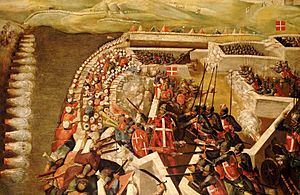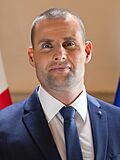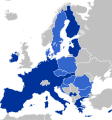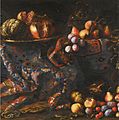Malta facts for kids
Quick facts for kids
Republic of Malta
Repubblika ta' Malta (Maltese)
|
|
|---|---|
![Location of Malta (green circle)– on the European continent (light green & dark grey)– in the European Union (light green) — [Legend]](/images/thumb/6/63/EU-Malta.svg/350px-EU-Malta.svg.png)
Location of Malta (green circle)
– on the European continent (light green & dark grey) |
|
| Capital | Valletta 35°54′N 14°31′E / 35.900°N 14.517°E |
| Official languages | |
| Other languages |
|
| Ethnic groups
(2021)
|
|
| Religion
(2021)
|
|
| Demonym(s) | Maltese |
| Government | Unitary parliamentary republic |
| Myriam Spiteri Debono | |
| Robert Abela | |
| Legislature | Parliament of Malta |
| Independence
from the United Kingdom
|
|
| 21 September 1964 | |
|
• Republic
|
13 December 1974 |
| Area | |
|
• Total
|
316 km2 (122 sq mi) (187th) |
|
• Water (%)
|
0.001 |
| Population | |
|
• 2021 census
|
519,562 |
|
• Density
|
1,649/km2 (4,270.9/sq mi) (8th) |
| GDP (PPP) | 2024 estimate |
|
• Total
|
|
|
• Per capita
|
|
| GDP (nominal) | 2024 estimate |
|
• Total
|
|
|
• Per capita
|
|
| Gini (2020) | ▲ 31.4 medium |
| HDI (2022) | very high · 25th |
| Currency | Euro (€) (EUR) |
| Time zone | UTC+1 (CET) |
|
• Summer (DST)
|
UTC+2 (CEST) |
| Calling code | +356 |
| ISO 3166 code | MT |
| Internet TLD | .mt |
|
|
Malta, officially the Republic of Malta, is a small island country in the middle of the Mediterranean Sea. It is located south of Italy, east of Tunisia, and north of Libya. The country is an archipelago, which means it's a group of islands. The three largest islands are Malta, Gozo, and Comino.
Malta's two official languages are Maltese and English. Its capital city, Valletta, is the smallest capital in the European Union (EU). Even though Malta is one of the smallest countries in the world, it is very crowded. With over 500,000 people, it is the ninth most densely populated country.
Because of its location, Malta has been very important throughout history. Many different powers have ruled the islands, including the Phoenicians, Romans, Arabs, Knights Hospitaller, French, and British. Each of these groups left its mark on Maltese culture.
Malta became independent from the United Kingdom in 1964 and became a republic in 1974. It joined the European Union in 2004 and started using the Euro as its currency in 2008.
Today, Malta is a popular place for tourists. People visit for its warm weather, beautiful sights, and historic buildings. It has three UNESCO World Heritage Sites, including ancient megalithic temples that are among the oldest free-standing structures in the world.
Contents
Name
The name Malta has a long history. It likely comes from the ancient Greek word Melítē, which means "place of honey" or "sweetness." The ancient Greeks might have named the island this because of a special type of bee that lives there.
Another idea is that the name comes from the Phoenician word Maleth, which means "haven" or "port." This would refer to the island's safe harbors. The name was later used by the Romans for the island and its ancient capital, Mdina.
History
Ancient Times
People have lived in Malta for over 8,500 years. The first settlers were probably hunter-gatherers from Sicily. Later, around 3500 BC, the people of Malta began building huge stone temples. These megalithic temples, like Ġgantija on Gozo, are some of the oldest free-standing buildings in the world.
Around 1000 BC, Phoenician traders arrived and used the islands as a stop on their trade routes. Later, Malta was ruled by Carthage and then by the Romans. During Roman times, in AD 60, Paul the Apostle was shipwrecked on the island. He stayed for three months and introduced Christianity to the Maltese people.
Middle Ages
After the Roman Empire fell, Malta was ruled by the Byzantine Empire. In 870, Arabs from North Africa conquered the islands. They introduced new farming methods and their language, Siculo-Arabic, which later evolved into the modern Maltese language.
In 1091, the Normans from Sicily took control of Malta. This brought the island back under Christian rule. For the next 400 years, Malta was part of the Kingdom of Sicily and was ruled by different European noble families.
The Knights of Malta
In 1530, the King of Spain gave Malta to the Knights Hospitaller, a religious and military group also known as the Knights of St. John. The Knights ruled Malta for over 250 years.
Their most famous moment was the Great Siege of Malta in 1565. The Ottoman Empire sent a huge army to capture the island, but the Knights and the Maltese people fought them off. After the victory, the Knights built the new capital city, Valletta, and many forts and towers along the coast.
French and British Rule
The Knights' rule ended in 1798 when Napoleon Bonaparte captured Malta. The French were not popular, and the Maltese people rebelled. They asked for help from Great Britain. The British helped drive out the French, and in 1814, Malta officially became part of the British Empire.
Malta was an important naval base for the British. During World War II, the island was heavily bombed by Italy and Germany. For their bravery during the war, King George VI awarded the entire island the George Cross, a high honor. The George Cross is still on Malta's flag today.
Independence
Malta became an independent country on 21 September 1964. It was first a constitutional monarchy with Queen Elizabeth II as the head of state. On 13 December 1974, Malta became a republic with its own president. The last British troops left in 1979.
In 2004, Malta joined the European Union, and in 2008, it adopted the Euro as its currency.
Government and Politics
Malta is a parliamentary republic. The government is based on the British system. The Parliament is made up of the President and the House of Representatives.
The President is the head of state, but their role is mostly ceremonial. The real power is held by the Prime Minister, who is the leader of the government.
There are two main political parties in Malta:
- The Labour Party (Partit Laburista)
- The Nationalist Party (Partit Nazzjonalista)
For local government, Malta is divided into 68 local councils. These councils are responsible for taking care of their towns and villages.
Geography
Malta is an archipelago in the central Mediterranean Sea. An archipelago is a chain or group of islands. Only the three largest islands—Malta, Gozo, and Comino—have people living on them. The landscape is made of low hills and terraced fields. The highest point is Ta' Dmejrek, which is 253 meters (830 ft) high.
Malta does not have any permanent rivers or lakes. It gets its fresh water from underground sources and from plants that turn seawater into fresh water. The coastline has many bays, which make good harbors.
Climate
Malta has a Mediterranean climate with mild, rainy winters and hot, dry summers. The average temperature is around 23°C (73°F) during the day.
In winter, temperatures are usually between 12°C and 18°C (54°F and 64°F). In summer, they range from 28°C to 34°C (82°F and 93°F). Malta gets a lot of sunshine, with over 3,000 hours of sun per year.
Economy
Malta has an advanced, high-income economy. The main parts of its economy are tourism, manufacturing (especially electronics), and financial services.
Because Malta is a small island, it has to import many things, including most of its food and energy. Its main natural resource is limestone.
Tourism is very important for Malta's economy. Millions of tourists visit each year to enjoy the sunny weather, beaches, and historical sites. Malta is also a popular location for filming movies and TV shows. Famous movies like Gladiator and Troy were filmed there.
People and Culture
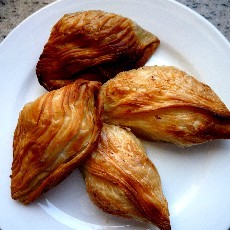
As of 2021, most of the people living in Malta were born there. There are also many people from other countries, especially the United Kingdom, Italy, and India.
Languages
The two official languages are Maltese and English. Maltese is a unique language that developed from an old form of Arabic spoken in Sicily. It is the only Semitic language in the European Union written with the Latin alphabet. Almost everyone in Malta can also speak English. Many people also speak Italian.
Religion
The main religion in Malta is Roman Catholic Christianity. The country has over 360 churches, which is about one church for every 1,000 people. Religion is an important part of Maltese culture, and many towns and villages celebrate the feast day of their patron saint with processions, band marches, and fireworks.
Cuisine
Maltese food is a mix of Mediterranean flavors, with strong influences from Sicily and Italy. Popular dishes include stuffat tal-fenek (rabbit stew), lampuki pie (fish pie), and pastizzi (flaky pastries filled with ricotta cheese or peas).
Festivals
Malta has many festivals throughout the year. The most important are the village festas (feasts) that honor each town's patron saint. These celebrations last for several days and include religious services, parades, music, and fireworks.
Another big event is Carnival, which is held in February before Lent. It features colorful floats, costumes, and parties in the streets.
Transportation
In Malta, people drive on the left side of the road, like in the United Kingdom. The main form of public transportation is the bus system, which connects all the towns and villages.
Malta International Airport is the only airport in the country. There are also ferry services that connect Malta to the island of Gozo and to Sicily in Italy. The Grand Harbour in Valletta is a major port for cruise ships and cargo.
Images for kids
-
The Ġgantija temples on Gozo are ancient megalithic structures.
-
Roger I of Sicily brought Christian rule back to Malta.
-
Flag of the Aragonese Kingdom of Sicily, which ruled Malta.
See also
 In Spanish: Malta para niños
In Spanish: Malta para niños




